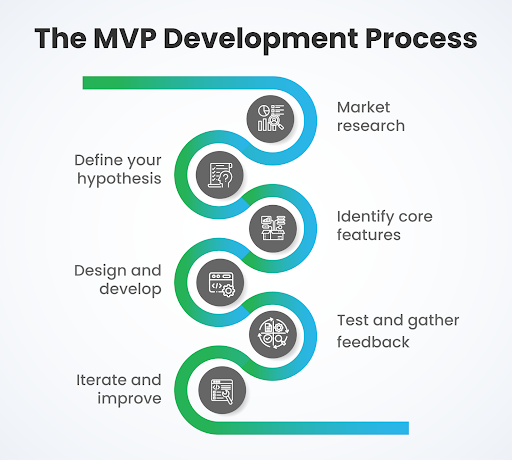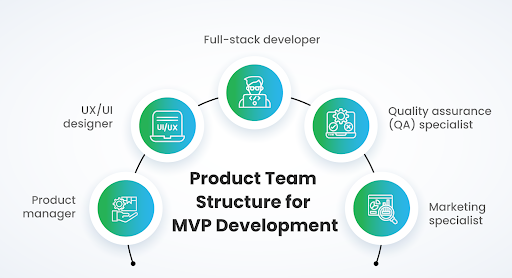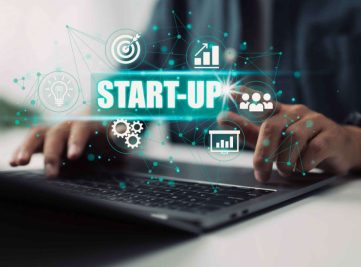Do you want to improve your chances of building a successful product? Create a Minimum Viable Product (MVP) first. Startups often make the mistake of developing products based on assumptions. A survey by CB Insights states that around 42% of startups fail because they focus on solving challenges that are interesting to solve instead of those that meet a market need. That’s why MVP software development is crucial to ensure you build a product that validates market need.
In this guide, we cover everything about MVP development, including what it is, why it’s important and how to build an MVP in software development. We will also discuss the ideal product team structure, as well as the most commonly used architecture and tech stacks for MVP software development. But before going into details, let us be clear about what is an MVP.
Also read- 13 Reasons Why Startups Fail
What is an MVP in software development?
An MVP in software development is a version of a product with core features necessary to attract early adopters. It helps the product owners to validate their product idea early. They can get user feedback to iterate and work upon the product for a wider user base.
Coined by Eric Ries and Steven Blank, the minimum viable product concept aligns perfectly with the lean startup approach.
The lean startup methodology serves as the inspiration behind MVP development. This approach reduces the need for a complete product building which may incur high costs and consume a lot of development team’s time.
MVPs play a crucial role in the agile methodology. It is because the latter depends on validation and iteration to develop products.
Why build MVP (Minimum viable product)?
MVPs can help early-stage companies test ideas and confirm demand. Large tech firms can also use MVPs to explore new investments or test product features. This approach, especially when implemented through MVP software development, is critical for both entrepreneurs looking to identify customer demands and investors assessing business prospects.
Building an MVP is essential for several reasons:
Validate idea:
An MVP helps you validate your business idea by testing it with real users. This ensures that you are building a product that meets the needs of your target audience and addresses a genuine problem. Without an MVP, you risk investing time and resources into a product that may not resonate with users or have a market demand.
Minimize risks:
Developing an MVP allows you to test your product with minimal costs and resources. Focusing on the core features allows you to assess your product’s viability quickly before committing to full-scale development. It minimizes the risk of spending too much time and money on a product that may not be successful in the market.
Gather feedback:
An MVP enables you to gather feedback from early adopters, which can be invaluable in refining your product and meeting user expectations. If you don’t build one and launch your product, you may end up without any takers.
Secure funding:
Investors are more likely to fund startups with a proven concept backed by real user feedback. An MVP demonstrates that your product has market potential and shows investors you are serious about your venture. If you don’t build one, your investors may view your idea as risky or unproven.
Building your own MVP becomes even easier when you know the right steps. To have a look over what each step involves you can access ours 8-step minimum viable product checklist developing a successful startup product.
The MVP software development process
The MVP software development process can be broken down into several key steps, which help validate your business idea, test the market, and gather essential feedback for future development. Here is a detailed breakdown of the process.

Market research
Before starting the MVP software development process, conduct some research on your target market to:
- Identify your competitors
- Understand customer pain points
- Create a unique value proposition based on insights
- Identify what you want to solve with your product
Market research will also help you understand market trends, customer preferences, and potential market gaps. These are must to position MVP effectively.
Define your hypothesis
Based on the research, develop a hypothesis with the outline of the problem your MVP will solve and the expected outcome. It can also spot the most critical and risky assumptions. A clear hypothesis can boost the MVP software development process and help you set key performance indicators (KPIs) to measure its success.
To make the hypothesis work, you must ask the following questions:
- Is there a demand for the product?
- Are the users willing to adopt it?
- Are they ready to pay for it?
- Can the hypothesis provide a better alternative than the existing one?
This hypothesis should be testable and measurable. Only then it can accurately evaluate your MVP’s effectiveness.
Identify core features
List the features you want in your product, then prioritize them based on what your audience want and the problem you are trying to solve. Identify the core features that directly tackle the problem and are essential for an MVP.
These features should provide immediate value to your users and help you get feedback on your value proposition. You can use frameworks like Value vs. Complexity Quadrant, Kano Model, Weighted Scoring Prioritization, RICE framework, ICE Scoring Model, MoSCoW method, Opportunity Scoring, and others.
Your framework should answer four primary questions:
- Are you working on the highest business value item?
- Is your product delivering value to customers?
- Does your work align with broader business objectives?
- Is the product to the viable for the market?
An MVP is a lean version of the actual product. Avoid unnecessary features to reduce development time and costs.
Design and develop
Create a wireframe or a prototype to visualize your MVP. This is crucial to refine the user interface (UI) and user experience (UX). UX and UI are important to make the product easy to navigate and engage users. Experienced UX/UI designers can groom the user story easily to make visually appealing MVP that are easy to use and loaded with core features.
A well-designed MVP can also help you convince stakeholders and investors. It can simplify the process of raising fund for the future.
Once you finalize the design, start developing the product. Your developers must follow best practices, such as using version control, writing clean and modular code, and an agile development methodology.
Test and gather feedback
Once the MVP is ready, test it with your target audience to:
- Collect feedback
- Derive actionable insights
- Analyse results
- Iterate
- Refine the product
You can do testing via different channels like beta testing, focus groups, and user interviews. Collect both quantitative and qualitative feedback for a comprehensive understanding of your MVP’s strengths and weaknesses.
Iterate and improve:
Based on the feedback, refine your MVP, and repeat the testing process until your product meets your target audience’s needs. Be prepared to make changes to your MVP, such as adding new features, removing unnecessary ones, or adjusting the UI/UX.
This iterative approach takes your product closer to the user expectations and provides maximum value.
The MVP development process is a continuous cycle of research, development, testing, and iteration. These steps can help you create a solid foundation for your product, minimize risks, and increase the chances of success in the market. Always prioritize user feedback, as it helps refine your MVP and meet your target audience’s needs.
Product team structure for MVP software development
Developing scalable MVP requires proper grooming of the user story and effective prioritization of features. User story gives insights regarding what problems the product will solve. Prioritizing features is crucial to get the product-market-fit in time.
To get these points right, the MVP team must:
- Test the product hypothesis with minimum resources
- Come up with a basic solution to solve the problem
- Design and develop a viable product
- Gather and analyse feedback for iteration and improve
The productivity of these steps depend on the product team structure. The team must include- An efficient product development team for MVP should have the following roles:

Product manager
Product managers are responsible for defining the product vision, setting priorities, and managing the MVP software development process. They act as the bridge between the business and technical sides of the project, ensuring that the product aligns with both user needs and company goals.
UX/UI designer
UX/UI designers ensure the product is visually appealing and user-friendly. They design wireframes, mockups, and prototypes to visualize the product and work closely with the development team to implement the designs.
Full-stack developer
Full-stack developers handle both front-end and back-end development, ensuring the smooth functioning of the product. They work with the product manager and UX/UI designer to build and maintain the product according to the specified requirements.
Quality assurance (QA) specialist
QA specialists monitor and test the product to make it bug-free and meet quality standards. They work closely with the development team to identify and resolve any issues that may arise during the development process.
Marketing specialist
Marketing specialists promote the MVP and gather user feedback. They develop and execute marketing strategies to reach the target audience, generate interest, and collect valuable feedback to iterate on the product.
Most used architecture and tech stacks for MVP software development
Specific product requirements, budget, and timeline drive the architecture and tech stack choices for an MVP.
Here are some suggestions for popular and reliable technologies to help you build a robust MVP:
Front-end
The front-end in software development includes the software and hardware necessary to build the user interface. This is the part which the user sees or interacts with.
| React | A popular JavaScript library developed by Facebook, React is known for its flexibility, performance, and large developer community. It is suitable for creating interactive user interfaces for various back-end frameworks. |
| Angular | Developed by Google, Angular is a powerful front-end framework that enables developers to build dynamic web applications. Its extensive set of features and two-way data binding make it ideal for creating complex applications. |
| Vue.js | A lightweight and easy-to-learn JavaScript framework, Vue.js is suitable for small to medium-sized projects. Startups prefer it for its simplicity, flexibility, and performance. |
Back-end:
The back-end in software development involves site structure, system, data, and logic. It is normally a computer application or a program’s code that users cannot access.
| Node.js | A popular choice for building scalable and high-performance applications, Node.js is a JavaScript runtime that allows developers to use the same language for both front-end and back-end development. |
| Ruby on Rails | A full-stack web application framework built on the Ruby programming language, Ruby on Rails is known for its simplicity, convention-over-configuration approach, and fast development cycles. Startups looking to build and iterate on their MVPs quickly prefer this. |
| Django | Built on Python, Django is a high-level web framework that encourages rapid development and clean, pragmatic design. Its built-in features and extensive library support are ideal for developing feature-rich applications. |
Database:
A database, in a computer system, is an organized collection of electronically stored structured information or data. Accessing the same requires a database management system or DBMS.
| PostgreSQL | A powerful, open-source, object-relational database system, PostgreSQL is known for its reliability, extensibility, and performance. It is suitable for handling large volumes of data and complex queries. |
| MySQL | A popular open-source relational database management system, MySQL is known for its ease of use, performance, and scalability. It is suitable for small to medium-sized applications and compatible with various programming languages. |
| MongoDB | A NoSQL database, MongoDB is known for its flexibility, horizontal scalability, and high performance. It is perfect for applications that require handling large amounts of unstructured data. |
MVP vs. prototype vs. PoC: Understanding the differences
| Feature | MVP (Minimum Viable Product) | POC (Proof of Concept | Prototype |
| Purpose | Validate market demand & gather user feedback | Validate technical feasibility | Demonstrate product concept & user experience |
| Functionality | Fully functional product with core features | Limited functionality, may not be user-facing | Simulates look & feel, may not be fully functional |
| Target Audience | Early adopters & potential customers | Internal stakeholders & developers | Stakeholders, designers, & potential users |
| Development Time & Cost | Highest investment, requires development of core functionalities | Lowest investment, may involve technical demos or reports | Moderate investment, depends on complexity & interactivity |
| Focus | Business value & user needs | Technical feasibility & risk reduction | User experience & design iteration |
| Example | First version of a mobile app with core features | Technical report demonstrating the viability of integrating blockchain technology | Interactive mockup of a website homepage |
In a nutshell:
- An MVP is like a first draft – functional but basic, focused on getting early user feedback.
- A POC is like a preliminary sketch – explores technical possibilities to see if an idea can work.
- A prototype is like a visual model – demonstrates the look, feel, and interaction of a product.
Tips and thumb rules for perfect MVP software development
Developing a perfect MVP doesn’t require the knowledge of rocket science. The following tips can help you turn your MVP into a great success. To develop a successful MVP, startup founders should follow these tips and thumb rules:
Clearly define your target audience
A well-defined target audience is crucial for tailoring your MVP to users’ specific needs and preferences. Conduct market research to identify your ideal customers, their demographics, and their pain points to build a product that users will love.
Keep it simple
MVPs help you validate your core value proposition with minimal features. Focus on the essential features that directly address the problem and provide value to users instead of distracting users and creating additional complexity with unnecessary features. A simple, streamlined MVP enables you to gather feedback more effectively and iterate quickly.
Prioritize user experience
A great user experience (UX) is vital for user adoption and retention. Collaborate with your UX/UI designers to build an MVP that is visually appealing, user-friendly, engaging, meets users’ expectations, and delivers a seamless experience. Pay attention to details like navigation, layout, and content to make your MVP more adoption-ready.
Collect and analyze feedback
User feedback is the cornerstone of MVP software development. Implement various feedback channels like surveys, interviews, and analytics to gather insights from your early adopters. Analyze them to identify patterns, trends, and areas for improvement, make data-driven decisions, and iterate on your product to meet users’ needs.
Be prepared to pivot
Not every MVP will be an instant success, and that’s perfectly fine. If your MVP doesn’t achieve the desired results or the market conditions change, be prepared to change your approach or the entire business model. Use the feedback to identify new opportunities and pivot.
Set realistic expectations and timelines
Building an MVP requires time, effort, and resources. Avoid rushing the development. Instead, set realistic expectations and timelines for your team to focus on quality and ensure that your MVP reflects your vision.
Involve stakeholders early
Engage key stakeholders, such as investors, advisors, and potential customers, during the MVP development process. Their feedback and insights can help you refine the product and increase its chances of success. By involving them early, you can build trust and foster strong relationships that may prove valuable in the long run.
Stay flexible and adaptable
The MVP software development process involves constant iteration and learning. Be open to change and adapt your product based on the feedback received. Embrace a growth mindset and view setbacks as opportunities to learn and improve.
By following these tips and thumb rules, you can create an MVP that effectively validates your business idea, provides valuable user insights, and sets the foundation for a successful product.
Real-life examples of MVP software development
If you study MVP Software Development Examples, you will get valuable insights about what worked for them and what didn’t. They will help you ensure better outcomes from your own MVP.

Successful MVP software development examples
Dropbox
The file-sharing platform’s MVP was a simple video demonstrating the product’s core functionality. This approach helped Dropbox gauge user interest and attract early adopters without investing in full-scale development. The video showcased the seamless file synchronization and sharing capabilities, generating a waiting list of over 75,000 users overnight.
What worked?
Dropbox used early validation to refine the product, raise funding, and scale up. In the following 7 months, they acquired over a million users.
Airbnb
The founders of Airbnb initially launched a basic website to rent out air mattresses in their own apartments to conference attendees. The MVP was simple, featuring only a few listings and no advanced features like online payments or messaging.
What worked?
The initial success and user feedback allowed the founders to iterate the platform and add more features, eventually growing Airbnb into the global marketplace it is today.
Zappos
Before becoming a billion-dollar online shoe retailer, Zappos’ founder Nick Swinmurn started with an MVP, essentially a simple website with photos of shoes from local stores. He didn’t hold any inventory; instead, he would buy shoes from the store after an order on the website.
What worked?
Nick Swinmurn’s approach helped him to validate the demand for online shoe shopping without investing in inventory or infrastructure. Once validated, the company expanded its offerings as the business grew and developed a full-fledged eCommerce platform.
Amplify.ai
embraced the MVP approach, continuously iterating and adding functionalities based on user feedback.
This adaptability allowed them to pivot and validate their product across different markets, ultimately achieving a perfect product-market fit. Their rapid development and willingness to adapt secured them seed funding and a successful acquisition.
What worked?
Using an MVP approach allowed Amplify.ai to gather user feedback and continuously improve their product. This adaptability ensured they were building something customers truly wanted.
Rubix Data Sciences
Rubix Data Sciences aimed to simplify decision-making for B2B professionals. Instead of a complex initial product launch, they manually tested their core offering with potential customers. This validation process confirmed a need in the market. With the positive feedback, they set an ambitious 120-day deadline for their first MVP.
Their commitment to a tight timeline resulted in a well-received product that acquired 5 B2B customers within a month and secured funding from industry professionals.
What worked?
Rubix Data Sciences validated their idea with a manual testing phase before building an MVP. This early validation ensured they were solving a real problem and helped them secure funding for further development
Unsuccessful MVP software development examples
Quibi
Quibi was a short-form streaming platform launched in 2020, targeting mobile users. It raised over $1.75 billion in funding and had an all-star lineup of content creators. But the company didn’t develop a proper MVP before the full-scale launch and got shutdown within six months of launch.
What didn’t work?
Quibi invested heavily in content production and marketing without understanding their target audience’s preferences. The lack of user feedback and market validation led to the collapse.
Google Glass
Google’s ambitious augmented reality glasses project aimed to provide users with a hands-free, immersive experience. Despite the initial hype, Google Glass faced criticism over privacy concerns, battery life, and a high price tag. Google released the product to a limited group of early adopters called “Glass Explorers”.
What didn’t work?
Google’s feedback loop was not as effective as it should have been. This led to bad product-market fit and forced the company to discontinue the project.
Juicero
Juicero, a smart juicer startup, raised over $120 million in funding. The company’s MVP was an expensive, WiFi-enabled juicer that could only press proprietary juice packs. It failed to find customers due to its high price, unnecessary complexity, and the fact that the juice packs could be squeezed by hand.
What didn’t work?
The company didn’t groom the user story properly due to which they built an over-engineered and expensive product.
Read also: Innovation in Startups: 5 Experience Based Examples
Common mistakes and how to avoid them
Building a minimum viable product (MVP) is an important initial step for both new and established organizations, but it’s easy to make mistakes along the way. Avoiding these common mistakes can significantly improve your chances of success. Below are some of the top risk indicators to look out for, and solutions to avoid them:
Overengineering (feature creep)
The “minimum” in the MVP is crucial. Don’t include features that aren’t essential to validating your main hypotheses.
Solution – Clearly define the core features of your MVP from the beginning and rank them in order of importance.
How to do this?
- To categorize features, use a priority matrix (e.g., the MoSCoW method. Must Have, Should Have, Could Have, Won’t Have).
- Create user stories that focus on the core functionality needed to validate your key assumptions.
- Organize a “feature pruning” session with your team to remove any unnecessary features.
Prioritizing technology over user needs
While it may be appealing to create a technically amazing product, it will fail if it fails to address a practical need of people.
Solution –To understand the requirements and problems of your target audience, conduct extensive user research.
How to do this?
- Conduct user interviews. Speak directly to potential consumers to better understand their needs and problems. Prepare open-ended questions and listen carefully to the answers.
- Create user profiles based on your findings. This will allow you to empathize with their needs.
- Perform usability testing. Observe how consumers interact with prototypes or early versions of your MVP to uncover usability issues.
Ignoring user input
The whole point of an MVP is to gather user input. If you ignore it, it will be pointless.
Solution-Put a mechanism in place to collect and evaluate user input and be prepared to make iterations based on what you receive.
How to do this?
- Create feedback mechanisms. Use in-app feedback forms, surveys, or specialized feedback channels (e.g. email, forums).
- Use analytics tools. Monitor user activity within your MVP to spot usage trends and opportunities for improvement.
- Implement a feedback review process. Regularly evaluate and analyze feedback with your team and prioritize improvements based on user feedback.
Not defining clear metrics
You won’t be able to determine how your MVP is performing without clear metrics.
Solution- For your MVP, set SMART (specific, measurable, attainable, relevant, and time-bound) goals. Track important KPIs in advance, such as customer satisfaction, conversion rates, and user engagement to measure your development.
How to do this?
- Define specific KPIs. Choose metrics that are closely related to your MVP goals (e.g. number of signups, feature usage, task completion rate).
- Use analytics tools. Use technologies like Google Analytics, Mixpanel, or other comparable platforms to measure these KPIs.
- Create dashboards and reports. Visualize your data to more easily track progress and spot patterns.
Launching to wrong audience
Testing with the wrong audience can produce false results.
Solution- Clearly identify your target audience and make sure your MVP reaches them.
How to do this?
- Generate comprehensive user profiles. Describe the demographics, psychographics, and demands of your ideal customer.
- Implement focused marketing and outreach strategies. Reach your target audience using the right mediums (e.g., social media, industry events, online communities).
- Perform focused beta testing. Find beta testers who closely match your target customer profile.
By avoiding these common mistakes, you can increase the value of your MVP and improve your chances of creating a successful product.
Building successful Generative AI MVPs
While the fundamental concepts of MVP software development remain crucial, generative AI (GenAI) poses a different set of challenges compared to traditional software. Product managers exploring this domain must adjust their approach to the different goals and limitations of GenAI. This involves deciding whether to use pre-trained APIs or invest in developing large language models in-house.
The key here is not to build a fully functional model right away, but rather to create a “minimum viable experience” (MVE). This MVE should adequately demonstrate the capabilities of your AI-powered solution. Instead of focusing on extensive functionality, consider providing a core experience that highlights the value proposition of your GenAI.
Balance is key. Recognizing the time and resources required for AI models while prioritizing a clear user experience that showcases crucial GenAI capabilities. Pretrained APIs can speed development and deliver robust capabilities.
The MVE is crucial to collect user input. Use this feedback to improve your GenAI product and ensure it offers real value. A successful GenAI MVP:
- Generate excitement among the audience by glimpsing the possibilities of your AI.
- Provides a platform to get valuable information from users.
- Informs future iterations based on user interactions
By prioritizing user experience and leveraging pre-built solutions, product teams can create impactful GenAI MVPs that validate their concept and gather crucial feedback for future success.
Conclusion
In conclusion, a well-executed MVP Software development process is critical for startup founders to validate their business ideas and create successful products. By following the steps outlined in this guide, assembling the right team, and learning from both successful and unsuccessful examples, you can significantly increase your chances of developing and launching a successful MVP product.
If you want to turn your ideas into market-fit products, we can help you increase your chances. At Talentica, we help entrepreneurial teams to build and launch their product/service. Whether you are an early-stage startup or looking at growth, scaling, or transformation, with our unique approach and technical expertise, we can take your idea to the next step and develop an MVP that works.
Interested? Let us discuss your idea in a 30-minute free call with our expert and start building your MVP today!
FAQs
How much time and money should I invest in an MVP?
There’s no one-size-fits-all answer, but the goal is to be efficient. The best MVPs are built quickly and with minimal resources. 3-6 months is a common timeframe for minimum viable product software development.
How can I measure the success of my MVP?
There are various metrics you can use to measure the success of your minimum viable product, such as:
- User engagement: How long are users spending on the platform? How often are they coming back?
- User acquisition: How many users are signing up for your MVP?
- Conversion rate: Are users taking the desired action, such as making a purchase or signing up for a trial?
- Net Promoter Score (NPS): How likely are users to recommend your MVP to others?
How does AI integration improve the MVP development process? <h3>
Integrating artificial intelligence (AI) to MVP development not only simplifies things but also enhances the user experience. Interestingly, 75% of businesses have already adopted AI and machine learning technology to enhance their software offerings.
For example, AI-powered chatbots can effectively answer consumer questions, increasing revenue by 67% because they can handle multiple inquiries at once. Integrating AI early in the MVP lifecycle ensures that the final product is intuitive and responsive.
How much does MVP software development cost?
The cost of MVP software development can vary greatly depending on the complexity of your product, the features of the MVP, and the team or agency you choose.
MVPs typically cost between a few thousand dollars for a simple product and tens of thousands of dollars for more powerful and complicated solutions.
To ensure your MVP meets your goals without exceeding your budget, you need to strike a balance between cost and required functionality.
Should MVP development be outsourced or kept in-house?
Outsourcing or in-house development hinges on internal capabilities and resources. Outsourcing can mean access to special skills and speed of development, but in-house teams ensure direct control. A hybrid approach usually works best, with strategic oversight coupled with outside expertise.
Can MVP software development help you get funding?
Yes, MVP software development can play a significant role in getting funding. An MVP puts your concept into action, offering potential investors a concrete product rather than just an idea. Your MVP can validate your business model and attract investors by demonstrating user engagement, early traction, and feedback.
Investors are more inclined to invest when there is evidence of market interest and potential success. Startups with functional MVPs are 70% more likely to attract funding than their counterparts who solely have an idea.








